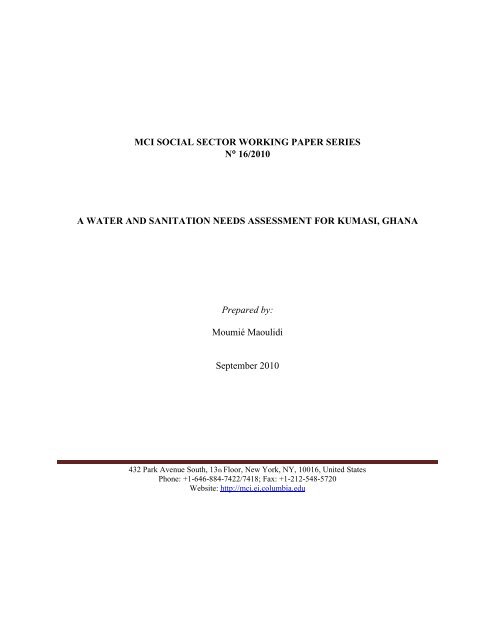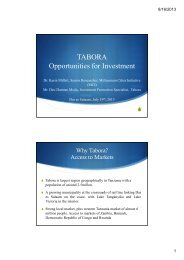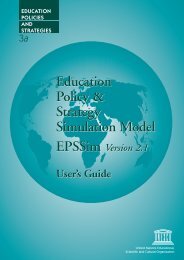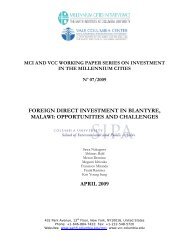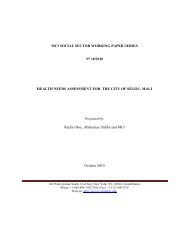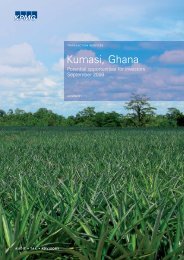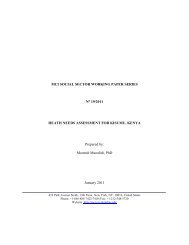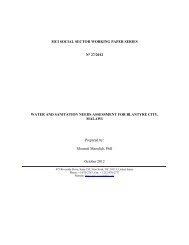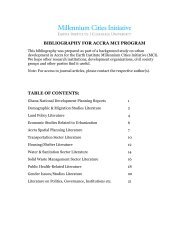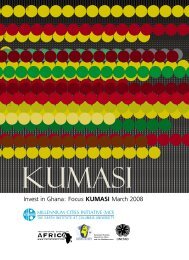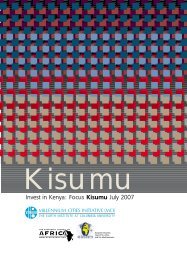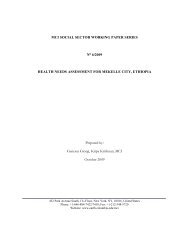A Water and Sanitation Needs Assessment for Kumasi, Ghana
A Water and Sanitation Needs Assessment for Kumasi, Ghana
A Water and Sanitation Needs Assessment for Kumasi, Ghana
You also want an ePaper? Increase the reach of your titles
YUMPU automatically turns print PDFs into web optimized ePapers that Google loves.
MCI SOCIAL SECTOR WORKING PAPER SERIES<br />
N 16/2010<br />
A WATER AND SANITATION NEEDS ASSESSMENT FOR KUMASI, GHANA<br />
Prepared by:<br />
Moumié Maoulidi<br />
September 2010<br />
432 Park Avenue South, 13th Floor, New York, NY, 10016, United States<br />
Phone: +1-646-884-7422/7418; Fax: +1-212-548-5720<br />
Website: http://mci.ei.columbia.edu
NB: This needs assessment was compiled by MCI Social Sector Research Manager Dr. Moumié<br />
Maoulidi, based on research conducted by Dr. Maoulidi, MCI Project Manager <strong>for</strong> <strong>Ghana</strong><br />
Abenaa Akuamoa-Boateng <strong>and</strong> MCI Researcher Andrea Castro. It was edited by MCI Co-<br />
Director Dr. Susan Blaustein with editorial support from MCI intern Devon McLorg.<br />
.<br />
2
Figure 1. Map of <strong>Ghana</strong> Showing <strong>Kumasi</strong><br />
Source: UN-HABITAT (2009)<br />
3
ACKNOWLEDGEMENTS<br />
The Millennium Cities Initiative would like to thank the following individuals <strong>and</strong> institutions <strong>for</strong> their<br />
invaluable assistance:<br />
Ms. Abenaa Akuamoa-Boateng, MCI <strong>Ghana</strong> Project Manager<br />
<strong>Kumasi</strong> Metropolitan Assembly (KMA)<br />
The Honorable Mayor <strong>and</strong> CEO of the KMA, Mr. Samuel Sarpong<br />
Mr. Edward Afari Gyem, Metropolitan Coordinating Director<br />
Mr. Justice Kingsley-Of<strong>for</strong>i, Head, Finance <strong>and</strong> Budget<br />
Mr. Samuel Brobbey, Principal Accountant<br />
<strong>Ghana</strong> <strong>Water</strong> Company Limited (GWCL)<br />
Mr. Stevens Ndebugri, Director<br />
Mr. Quacoe William, GWCL Statistician<br />
Mr. Samuel M. Gikunoo, Regional GIS Officer<br />
Ms. Gloria O<strong>for</strong>i-Yeboah, GWCL GIS Office<br />
Mr. Maxwell Akosah-Kusi, GWCL GIS Office<br />
<strong>Kumasi</strong> Metropolitan Assembly Waste Management Department (WMD)<br />
Mr. Anthony Mensah, Director<br />
Ms. Augustine Agyei-Boateng, Head, Research <strong>and</strong> Development<br />
Mr. John Donkor, Head, Public Health <strong>and</strong> <strong>Sanitation</strong><br />
Mr. Asssibey Bonsu, Statistician<br />
International <strong>Water</strong> Management Institute (IWMI)<br />
Ms. Liqa Raschid-Sally, Wastewater Specialist<br />
4
TABLE OF CONTENTS<br />
ACKNOWLEDGEMENTS ............................................................................................................ 4<br />
LIST OF TABLES .......................................................................................................................... 6<br />
LIST OF FIGURES ........................................................................................................................ 6<br />
LIST OF ABBREVIATIONS ......................................................................................................... 7<br />
EXECUTIVE SUMMARY ............................................................................................................ 8<br />
I. INTRODUCTION ....................................................................................................................... 9<br />
1.1. Objectives .......................................................................................................................... 10<br />
1.2. Methodology ...................................................................................................................... 10<br />
1.3. Limitations ......................................................................................................................... 10<br />
1.4. Demographics .................................................................................................................... 10<br />
II. WATER AND SANITATION IN KUMASI ........................................................................... 11<br />
2.1. Background ........................................................................................................................ 11<br />
2.2. <strong>Kumasi</strong>’s <strong>Water</strong> System ..................................................................................................... 12<br />
2.3. Access to <strong>Water</strong> in <strong>Kumasi</strong> ................................................................................................ 14<br />
2.4. <strong>Kumasi</strong>’s <strong>Sanitation</strong> System .............................................................................................. 17<br />
2.5. Access to <strong>Sanitation</strong> in <strong>Kumasi</strong> ......................................................................................... 22<br />
2.6. Hygiene Education ............................................................................................................. 22<br />
III. FINANCING WATER AND SANITATION IN KUMASI .................................................. 23<br />
3.1. Financing <strong>Water</strong> <strong>and</strong> <strong>Sanitation</strong> ......................................................................................... 23<br />
3.2. <strong>Water</strong> <strong>and</strong> <strong>Sanitation</strong> Projects in <strong>Kumasi</strong> .......................................................................... 23<br />
3.3. Costing Model .................................................................................................................... 24<br />
3.4. Results of the Costing Model ............................................................................................. 26<br />
IV. CONCLUSION AND RECOMMENDATIONS ................................................................... 28<br />
REFERENCES ............................................................................................................................. 29<br />
APPENDIX 1. MONTHLY WATER PRODUCTION IN 2006 & 2009 .................................... 31<br />
APPENDIX 2. <strong>Sanitation</strong> Budget <strong>for</strong> 2008 .................................................................................. 32<br />
5
LIST OF TABLES<br />
Table 1. <strong>Kumasi</strong> City Population, by Area ................................................................................... 11<br />
Table 2. Storage Capacity <strong>and</strong> Condition of <strong>Water</strong> Tanks at Suame............................................ 13<br />
Table 3. <strong>Water</strong> Dem<strong>and</strong> Forecast (m 3 /day) <strong>for</strong> <strong>Kumasi</strong> ............................................................... 14<br />
Table 4. Definition of Improved <strong>and</strong> Unimproved <strong>Water</strong> Sources ............................................... 15<br />
Table 5. Types <strong>and</strong> Numbers of Public Toilets in <strong>Kumasi</strong> Metropolis (2008) ............................. 18<br />
Table 6. Waste Generation in <strong>Kumasi</strong>, by Sub-Metropolitan Area, 2006-2009........................... 19<br />
Table 7. Composition of Municipal Solid Waste (MSW) in 2009. .............................................. 20<br />
Table 8. Definition of Improved <strong>and</strong> Unimproved <strong>Sanitation</strong> Facilities ...................................... 22<br />
Table 9. <strong>Sanitation</strong> Coverage in <strong>Kumasi</strong> (2000 & 2008) .............................................................. 25<br />
Table 10. Select Unit Costs Used in the Costing Model............................................................... 26<br />
Table 12. Alternative scenario ...................................................................................................... 27<br />
LIST OF FIGURES<br />
Figure 1. Map of <strong>Ghana</strong> Showing <strong>Kumasi</strong> ..................................................................................... 3<br />
Figure 2. Map of <strong>Kumasi</strong> Showing Sub-Metropolitan Areas <strong>and</strong> Major Roads ............................ 9<br />
Figure 3. Map of <strong>Kumasi</strong> Showing Surface <strong>Water</strong> Sources <strong>and</strong> Intake Points ............................ 12<br />
Figure 4. <strong>Water</strong> Pipelines in <strong>Kumasi</strong> ............................................................................................ 15<br />
Figure 5. Metering Status in <strong>Kumasi</strong> Metropolis <strong>and</strong> Peri-urban Areas. ...................................... 16<br />
Figure 6. Public <strong>Sanitation</strong> Facilities Used in <strong>Kumasi</strong> ................................................................. 18<br />
Figure 7. Treatment Plant at Asafo <strong>and</strong> Overloaded Anaerobic Pond at Ahesan ......................... 21<br />
6
LIST OF ABBREVIATIONS<br />
AVRL Aqua Vitens R<strong>and</strong> Limited<br />
DACF District Assemblies Common Fund<br />
EPA Environmental Protection Agency<br />
GOG Government of <strong>Ghana</strong><br />
GWCL <strong>Ghana</strong> <strong>Water</strong> Company Limited<br />
IDA International Development Association<br />
IWMI International <strong>Water</strong> <strong>and</strong> Management Institute<br />
KMA <strong>Kumasi</strong> Metropolitan Assembly<br />
KNUST Kwame Nkrumah University of Science <strong>and</strong> Technology<br />
KVIP <strong>Kumasi</strong> Ventilated Improved Pit Latrine<br />
MSW Municipal Solid Waste<br />
NGO Non-Governmental Organization<br />
SANDEC Department of <strong>Water</strong> <strong>and</strong> <strong>Sanitation</strong> in Developing Countries at the Swiss Federal<br />
Institute of Aquatic Science <strong>and</strong> Technology (Eawag)<br />
SSP Strategic <strong>Sanitation</strong> Plan<br />
UESP Urban Environmental <strong>Sanitation</strong> Project<br />
UNDP United Nations Development Programme<br />
UNICEF United Nations Children’s Fund<br />
WB World Bank<br />
WHO World Health Organization<br />
WMD Waste Management Department<br />
7
EXECUTIVE SUMMARY<br />
<strong>Kumasi</strong>, <strong>Ghana</strong>’s second largest city, is located in south-central <strong>Ghana</strong> <strong>and</strong> is a commercial,<br />
industrial <strong>and</strong> cultural center with a rapidly increasing population. 1 The city is making progress<br />
towards Target 7C of the Millennium Development Goals, which m<strong>and</strong>ates that the number of<br />
people without sustainable access to water <strong>and</strong> sanitation be reduced by half by 2015. However,<br />
while access to piped water in <strong>Kumasi</strong> has increased from 66.2 percent in 2000 to 80 percent in<br />
2008, <strong>and</strong> solid waste collection is improving, about 40 percent of the city’s residents still rely on<br />
public <strong>and</strong> shared toilets. Since public <strong>and</strong> shared toilets are not considered to be ―improved<br />
sanitation facilities‖ by the WHO/UNICEF Joint Monitoring Programme (JMP), the city today,<br />
with little more than four years to go, remains far from attaining the sanitation target. 2<br />
<strong>Water</strong> production in <strong>Kumasi</strong> has been exp<strong>and</strong>ing in recent years, with an increase from 21 to 27<br />
million gallons per day between 2005 <strong>and</strong> 2010 (Blokhuis et al., 2005; GWCL, 2010). However,<br />
average per capita daily consumption has been declining, due largely to <strong>Kumasi</strong>’s fast-growing<br />
population, in light of which, both water production <strong>and</strong> the water supply network need to be<br />
exp<strong>and</strong>ed soon <strong>and</strong> significantly. Additional water supply challenges include the irregular water<br />
supply <strong>and</strong> leakages from pipes. Irregular, <strong>and</strong> hence, unreliable water supply is mainly the<br />
result of frequent power outages, a chronic problem afflicting all of <strong>Ghana</strong> in recent years.<br />
<strong>Water</strong> loss from leakages, though, is expected to decline, given the ongoing ef<strong>for</strong>t of <strong>Ghana</strong><br />
<strong>Water</strong> Company Limited (GWCL), to replace the old pipes <strong>and</strong> extend the water main.<br />
The <strong>Kumasi</strong> Metropolitan Assembly’s Waste Management Department (WMD) has also made<br />
significant progress in improving sanitation in the city. Public toilets are being rehabilitated, <strong>and</strong><br />
the city has introduced both a house-to-house refuse collection scheme <strong>and</strong> a ―pay-as-you-dump‖<br />
system to deal with its solid waste collection challenges. As a result, open defecation is not a<br />
major problem, <strong>and</strong> heaps of uncollected solid waste are no longer a common sight, as they were<br />
a decade ago. The city is also committed to ensuring that schoolchildren <strong>and</strong> the population at<br />
large are well in<strong>for</strong>med about good hygiene practices. Nevertheless, major sanitation problems<br />
remain. ―A worrying trend is that about 40 percent of the city’s population uses public toilets,<br />
<strong>and</strong> only about half of all residents have toilet facilities at home.‖ Another persistent problem<br />
facing the WMD is inadequate revenue mobilization to finance sanitation services.<br />
The findings of this needs assessment indicate that with an average annual investment of $13 per<br />
capita, <strong>Kumasi</strong> has the opportunity to attain the MDG targets related to water <strong>and</strong> sanitation.<br />
The structure of the report is as follows: Section I presents an overview of the city, as well as the<br />
objectives, methodology <strong>and</strong> limitations of the study. Section II discusses key problems faced by<br />
residents, namely the availability, af<strong>for</strong>dability <strong>and</strong> suitability of water <strong>and</strong> sanitation services.<br />
Section III focuses on the financing <strong>for</strong> water <strong>and</strong> sanitation in <strong>Kumasi</strong> City <strong>and</strong> outlines the<br />
results of the costing model. Section IV summarizes the needs assessment’s findings <strong>and</strong> offers<br />
some recommendations.<br />
1 MCI estimates the 2010 population at 1.6 million, with a daytime population estimated at roughly 2 million.<br />
2 The JMP defines an improved sanitation facility as any of the following: a pit latrine; a ventilated improved pit<br />
latrine; a pit latrine with slab; a composting toilet; <strong>and</strong>/or a flush toilet piped to a sewerage system or septic tank.<br />
8
I. INTRODUCTION<br />
<strong>Kumasi</strong> is strategically positioned as the capital of <strong>Ghana</strong>’s Ashanti Region, one of the most<br />
heavily populated parts of the country. Located 300 km north-west of Accra, the national<br />
capital, <strong>Kumasi</strong> has been the crossroads between the northern <strong>and</strong> southern sections of <strong>Ghana</strong><br />
since its establishment as the heart of the Ashanti Empire, around the turn of the eighteenth<br />
century. The city is easily accessible by road <strong>and</strong> has a large transient <strong>and</strong> immigrant population<br />
from all parts of the country, as well as from neighboring West African countries. Figure 2<br />
shows the city’s 10 sub-metropolitan areas <strong>and</strong> its major roads.<br />
Figure 2. Map of <strong>Kumasi</strong> Showing Sub-Metropolitan Areas <strong>and</strong> Major Roads<br />
9
1.1. Objectives<br />
This paper aims to identify the main water <strong>and</strong> sanitation challenges facing the city of <strong>Kumasi</strong> in<br />
its ef<strong>for</strong>ts to achieve Target 7C (<strong>for</strong>merly Target 10) of Millennium Development Goal #7 -- to<br />
cut in half by 2015 the proportion of people without access to safe drinking water <strong>and</strong> basic<br />
sanitation. Going further, this study suggests specific interventions to improve that access <strong>and</strong><br />
estimates their costs, enabling local, regional <strong>and</strong> national government <strong>and</strong> the development<br />
partners to plan accordingly.<br />
1.2. Methodology<br />
The research methodology used in this needs assessment includes field research, a desk review<br />
<strong>and</strong> site visits. The field research was initially conducted in between February <strong>and</strong> April 2008 by<br />
a researcher who travelled to <strong>Kumasi</strong> to gather preliminary in<strong>for</strong>mation, work then followed up<br />
by MCI’s Social Sector Research Manager <strong>and</strong> Program Manager in <strong>Ghana</strong> in July 2010.<br />
Data <strong>and</strong> in<strong>for</strong>mation were obtained from representatives of various agencies in <strong>Kumasi</strong>,<br />
including: <strong>Ghana</strong> <strong>Water</strong> Company Limited (GWCL) <strong>and</strong> Aqua Vitens R<strong>and</strong> Limited (AVRL);<br />
The <strong>Kumasi</strong> Metropolitan Assembly (KMA) Waste Management Department (WMD); the<br />
International <strong>Water</strong> Management Institute; KMA Metropolitan Health Directorate (MHD); the<br />
Metropolitan Education Directorate <strong>and</strong> the School Health Education Program (SHEP); the<br />
KMA Town <strong>and</strong> Country Planning Department; <strong>and</strong> the wastewater treatment lagoons at Asafo<br />
<strong>and</strong> Ahensan Housing Estates. 3 Personal contact with WMD <strong>and</strong> AVRL employees, the KMA<br />
Statistical Office <strong>and</strong> staff at the IWMI office also provided unique opportunities <strong>for</strong> discussing<br />
water <strong>and</strong> sanitation issues.<br />
1.3. Limitations<br />
A key challenge in conducting this assessment was that data regarding the number of people with<br />
access to improved water <strong>and</strong> sanitation sources differed in different documents, partly because<br />
different population projections were used. Another limitation was that <strong>Kumasi</strong> has a significant<br />
immigrant <strong>and</strong> transient population. People migrate to the city from different parts of <strong>Ghana</strong> <strong>and</strong><br />
West Africa, <strong>and</strong> some Ashanti residents travel to <strong>Kumasi</strong> to work or trade during the day <strong>and</strong><br />
then return home at night, making it difficult to estimate the water supply <strong>and</strong> sanitation<br />
resources <strong>and</strong> facilities needed to achieve the MDG water <strong>and</strong> sanitation targets.<br />
1.4. Demographics<br />
<strong>Kumasi</strong> is the most populous district in the Ashanti region. As of the 2000 census, the city had a<br />
population of 1,170,270. MCI projects that the 2010 population is 1,634,899. 4 Data collection<br />
3 Ahensan is also spelled Ahinsan.<br />
4 MCI’s population projections are based on the 2000 census <strong>and</strong> rely on an exponential growth function <strong>and</strong> a<br />
growth rate of 3.34 percent. Using this growth rate, the MCI population projection <strong>for</strong> 2007 (1,478,869) is the same<br />
as that in the <strong>Kumasi</strong> Metropolitan Assembly’s reports. However, other KMA documents, such as the<br />
―Development Plan <strong>for</strong> <strong>Kumasi</strong> Metropolitan Area (2006-2009),‖ use a different population growth rate (5.4<br />
percent) <strong>and</strong> show divergent population figures.<br />
10
<strong>for</strong> the 2010 <strong>Ghana</strong> census is expected to begin in September 2010. Table 1 shows <strong>Kumasi</strong><br />
City’s population by location, both at the time of the 2000 census <strong>and</strong>, as projected, in 2010.<br />
Table 1. <strong>Kumasi</strong> City Population, by Area<br />
Sub-Metropolitan<br />
Area<br />
Census population<br />
2000<br />
O<strong>for</strong>ikrom 124,869<br />
Asawase 131,418<br />
Bantama 101,409<br />
Nhyiaeso 64,505<br />
Kwadaso 118,039<br />
Subin 100,979<br />
Manhyia 163,986<br />
Suame 114,751<br />
Old Tafo 128,022<br />
Asokwa 122,292<br />
Total 1,170,270<br />
Source: <strong>Ghana</strong> Statistical Services (2005); MCI projections<br />
II. WATER AND SANITATION IN KUMASI<br />
2.1. Background<br />
Projected population<br />
2010<br />
174,445<br />
183,595<br />
141,671<br />
90,115<br />
164,904<br />
141,070<br />
229,093<br />
160,310<br />
178,850<br />
170,845<br />
1,634,899<br />
Area<br />
(sq.km)<br />
54.1<br />
29.5<br />
30.6<br />
30<br />
34.2<br />
8.5<br />
17.1<br />
14.6<br />
6<br />
29.3<br />
253.9<br />
The Government of <strong>Ghana</strong>’s key water <strong>and</strong> sanitation policy objectives are to accelerate the<br />
provision of safe water <strong>and</strong> adequate sanitation facilities <strong>and</strong> to ensure the sustainable<br />
management of those facilities. Strategies <strong>for</strong> achieving these objectives include: the<br />
development of District <strong>Water</strong> <strong>and</strong> <strong>Sanitation</strong> Plans (DWSPs); improving community-owned <strong>and</strong><br />
-managed water supply systems; <strong>and</strong> strengthening public-private partnerships. The government<br />
is also interested in integrating hygiene education into water <strong>and</strong> sanitation delivery.<br />
The <strong>Ghana</strong> <strong>Water</strong> Company Limited (GWCL) is a state-owned company responsible <strong>for</strong><br />
producing <strong>and</strong> distributing potable water to the urban population nationwide. In <strong>Kumasi</strong>, GWCL<br />
provides water <strong>and</strong> manages household connections <strong>and</strong> public st<strong>and</strong> posts, as well as boreholes<br />
in peri-urban areas. The Ashanti Regional Office of Aqua Vitens R<strong>and</strong> Limited is the company<br />
managing the water systems on behalf of GWCL. <strong>Sanitation</strong> services are provided by the Waste<br />
Management Department (WMD) of the <strong>Kumasi</strong> Metropolitan Authority (KMA). WMD<br />
supervises the design <strong>and</strong> construction of public sanitation facilities <strong>and</strong> oversees the activities of<br />
the companies sub-contracted to collect household waste in the metropolis.<br />
<strong>Kumasi</strong> is located in a wet semi-equatorial zone <strong>and</strong> receives substantial amounts of rain each<br />
year. The major rainfall season is from April to July, <strong>and</strong> the minor season occurs between<br />
September <strong>and</strong> mid-November. Average yearly maximum rainfall is 214.3 mm in June <strong>and</strong> 165<br />
mm in September (KMA WMD, 2010). Figure 3 shows some of the open water sources, <strong>and</strong> the<br />
two water intake points in <strong>Kumasi</strong>.<br />
11
Figure 3. Map of <strong>Kumasi</strong> Showing Surface <strong>Water</strong> Sources <strong>and</strong> Intake Points<br />
2.2. <strong>Kumasi</strong>’s <strong>Water</strong> System<br />
12
Most of the water in <strong>Kumasi</strong> is obtained from rivers, such as the Offin <strong>and</strong> Owabi. These surface<br />
water sources are fed by several tributary streams, as shown in Figure 3. GWCL does not rely on<br />
boreholes <strong>for</strong> the city’s water supply. Rainwater harvesting used to be widely practiced in<br />
<strong>Kumasi</strong>, but urbanization <strong>and</strong> pollution have made it impractical. Emissions from a growing<br />
number of industries <strong>and</strong> vehicular fumes have increased the range <strong>and</strong> levels of pollutants in the<br />
city, including such toxic chemicals as platinum, palladium <strong>and</strong> lead.<br />
There are two water intake points: one at Owabi (located 10 km from the city); the other at<br />
Barekese (located 19 km from the city). 5 The abstracted water is treated at the Owabi <strong>and</strong><br />
Barekese <strong>Water</strong> Treatment Plants. 6 The water is stored at the Owabi reservoir, a stone masonry<br />
gravity dam constructed in 1928 that is 135 meters long <strong>and</strong> 11 meters high, <strong>and</strong> at the Barekese<br />
reservoir, a 15 meters high <strong>and</strong> 600 meters long earth-filled dam built between 1967 <strong>and</strong> 1971<br />
<strong>and</strong> rehabilitated in 1998.<br />
Average water production at Owabi <strong>and</strong> Bakerese headworks is 122,638 m 3 /day, or 27 million<br />
gallons per day 7 (GWCL, 2010). This is an improvement from five years ago, when the average<br />
daily output was 95,000 m 3 /day (Blokhuis et al., 2005). However, given that the design capacity<br />
of Bakerese is about 220,000 m 3 /day <strong>and</strong> that of Owabi is 13,600 m 3 /day, the total water<br />
produced by the two waterworks amounts to just over half the design capacity. Low electrical<br />
power voltage is a factor contributing to this deficit in water production. For instance, in 2006,<br />
Mr. Timothy Nettey, then Project Manager <strong>for</strong> <strong>Kumasi</strong> <strong>Water</strong> <strong>and</strong> Rehabilitation Expansion,<br />
noted that the dams required 415 volts to run the pumps but were receiving fewer than 390<br />
volts. 8<br />
There are four pumps at Bakerese <strong>and</strong> Owabi, with a capacity to pump 4,500 cubic meters (m 3 )<br />
per hour, which has improved the flow of water to residences <strong>and</strong> businesses (GWCL personal<br />
communication). After water is abstracted <strong>and</strong> processed at the treatment plants, it is pumped to<br />
a surface reservoir in Suame, <strong>for</strong> distribution to different parts of the city. Suame has an elevated<br />
tank <strong>and</strong> ground level tanks, with a total storage capacity of 19,090 m 3 (4.2 million gallons), as<br />
shown in Table 2.<br />
Table 2. Storage Capacity <strong>and</strong> Condition of <strong>Water</strong> Tanks at Suame<br />
Capacity Condition<br />
Tank # 1 10,000 m 3<br />
Tank #2 4,545 m 3<br />
Tank # 3 4,545 m 3<br />
Total 19,090 m 3<br />
Source: GWCL/AVRL<br />
Functional<br />
Good<br />
Good<br />
5 Note that Owabi <strong>and</strong> Barekese are outside the <strong>Kumasi</strong> district boundaries. These plants are also known as Owabi<br />
<strong>and</strong> Barekese Headworks. According to the KMA 2006-2009 Development Plan, Barekese is 16 km from the city.<br />
6 The treatment process involves chemical dosing, clarification, <strong>and</strong> filtration.<br />
7 1 cubic meter (m 3 ) is equal to 220.16 UK gallons.<br />
8 http://www.ghanaweb.com/<strong>Ghana</strong>HomePage/NewsArchive/artikel.php?ID=177728<br />
13
While water production has been increasing, the average per-capita daily water consumption in<br />
<strong>Kumasi</strong> has been decreasing, mainly because the population growth has outstripped supply.<br />
Kuma et al (2010) estimate that, in 1996, daily per capita water consumption was 24.2 m 3 /year<br />
(0.066 m 3 /day or 66 liters/day) <strong>and</strong> argue that in 2009, it should have been 0.094 m 3 /day or 94<br />
liters/day. GWCL, on the other h<strong>and</strong>, notes that current per capita daily water consumption<br />
varies depending on socio-economic status. Low-income residents, <strong>for</strong> example, consume<br />
0.025-0.035 m 3 /day, while middle-income residents consume 0.060-0.075 m 3 /day <strong>and</strong> upperincome<br />
residents consume over 0.120 m 3 /day. 9 Average water consumption also varies,<br />
depending on the number of people per household <strong>and</strong> each household’s location.<br />
<strong>Kumasi</strong>’s water production clearly needs to increase to meet dem<strong>and</strong>, as shown in Table 3.<br />
Table 3. <strong>Water</strong> Dem<strong>and</strong> Forecast (m 3 /day) <strong>for</strong> <strong>Kumasi</strong><br />
Dem<strong>and</strong> in Liters Production in Coverage,<br />
Year per day Liters per day %<br />
1990 69,678,000 68,200,000 98%<br />
2010 242,735,348 122,727,273 51%<br />
2011 256,382,827 150,021,032 59%<br />
2012 270,797,618 177,297,600 65%<br />
2013 286,022,863 204,574,100 72%<br />
2014 302,104,126 231,818,182 77%<br />
2015 319,089,538 231,818,182 73%<br />
Source: GWCL/AVRL<br />
The catchment area of Barekese has been under intense human pressure in recent years, which<br />
has reduced the yield from the dam. For instance, encroachment by private l<strong>and</strong> developers,<br />
farming <strong>and</strong> logging have contributed to high sediment levels entering the dam, which has<br />
detrimentally affected recent initiatives to exp<strong>and</strong> water production at Bakerese. <strong>Water</strong><br />
production at Owabi has not been adversely affected by encroachment, because the catchment<br />
area is the Owabi Forest Reserve which is restricted from human activity. However, Owabi only<br />
produces one sixth of the water produced at Barekese.<br />
Additional problems affecting the operations of the GWCL include leakages, illegal connections<br />
<strong>and</strong> non-payment of customers’ bills. 10<br />
2.3. Access to <strong>Water</strong> in <strong>Kumasi</strong><br />
Table 4 lists the improved <strong>and</strong> unimproved sources of water as defined by the WHO/UNICEF<br />
Joint Monitoring Programme (JMP). 11<br />
9 3 3 3<br />
One liter per day (l/day) is equivalent to 0.001 m /day; hence, 0.025 m /day =25 liters per day, 0.075 m /day =75<br />
liters per day <strong>and</strong> 0.120 m 3 /day =120 liters per day.<br />
10<br />
In 2005 the Ashanti Regional Minister noted that consumers owed the GWCL 33.6 billion cedis ($3.5 million);<br />
(http://www.modernghana.com/news/74315/1/kumasi-water-consumers-owe-33-billion-cedis.html; the exchange<br />
rate used is $1 = 9607 old <strong>Ghana</strong> cedis <strong>and</strong> was derived from www.oada.com.)<br />
14
Table 4. Definition of Improved <strong>and</strong> Unimproved <strong>Water</strong> Sources<br />
Improved <strong>Water</strong> Supply Source Unimproved <strong>Water</strong> Supply Source<br />
Individual household connection<br />
Piped water from a yard tap Tanker truck provided water<br />
Piped water obtained from a neighbor Vendor provided water<br />
Protected well/spring Unprotected well/spring<br />
Rain water harvesting Bottled water<br />
Source: http://www.wssinfo.org/definitions/infrastructure.html<br />
The <strong>Kumasi</strong> <strong>Water</strong> Supply System (WSS) currently has 1,005 km of pipeline, with diameters<br />
ranging between 13 <strong>and</strong> 600 mm. Pipes between 13 <strong>and</strong> 32 mm are being phased out <strong>and</strong><br />
replaced with 25 mm pipes, because the <strong>for</strong>mer are prone to breakage (Kuma et al., 2010).<br />
Figure 4 shows the functioning <strong>and</strong> non-functioning water pipelines in <strong>Kumasi</strong>.<br />
Figure 4. <strong>Water</strong> Pipelines in <strong>Kumasi</strong><br />
11 Tanker truck-provided <strong>and</strong> vendor-provided water are not considered improved sources because there is no<br />
quality control to ensure that the water is safe to drink. Bottled water is not considered improved because of concern<br />
<strong>for</strong> the quantity, rather than the quality, of supplied water. Using this JPM definition, it is estimated that<br />
approximately 80 percent of <strong>Kumasi</strong> residents had access to an improved water source in 2008.<br />
15
GWCL/AVRL recently upgraded <strong>and</strong> extended <strong>Kumasi</strong>’s water transmission mains, under the<br />
World Bank/GoG Urban <strong>Water</strong> Project. 12 The main objectives of this project were to increase the<br />
supply of water in the city by replacing worn-out water distribution networks <strong>and</strong> extending the<br />
water transmission mains by 45.9 km. 13 According to <strong>for</strong>mer Managing Director of the <strong>Ghana</strong><br />
<strong>Water</strong> Company Limited (GWCL), Mr. Kwaku Botchway, the upgrade <strong>and</strong> extension were<br />
necessary because the lines were faulty, resulting in significant wastage of treated water. 14<br />
To reduce the number of unbilled customers, GWCL/AVRL has also been installing 20,000 new<br />
meters <strong>and</strong> replacing 1,776 existing ones, as part of the <strong>Kumasi</strong> <strong>Water</strong> Supply Rehabilitation<br />
Project. This initiative will ensure that households with access to piped water pay, which is<br />
important because many <strong>Kumasi</strong> houses are built as rows of rooms around a central courtyard,<br />
where the water taps tend to be located. Figure 5 shows the metering status in 2010 in the<br />
<strong>Kumasi</strong> metropolis <strong>and</strong> the surrounding peri-urban areas. As can readily be seen, each area<br />
includes a substantial number of customers still without meters.<br />
Figure 5. Metering Status in <strong>Kumasi</strong> Metropolis <strong>and</strong> Peri-urban Areas.<br />
Source: GWCL/AVRL<br />
12 This project focused not only on water supply in <strong>Kumasi</strong> but also in Obuasi, Accra <strong>and</strong> Mampong.<br />
13 The 61.8-kilometer length of the water transmission mains, comprised of 45.9 km in <strong>Kumasi</strong> <strong>and</strong> 15.9 km in<br />
Obuasi, was added at a cost of GH¢400,600 ($276,275), with funding from the World Bank <strong>and</strong> the GoG.<br />
14 Areas benefitting from the extension include: the airport roundabout to Kenyase; Santase to Atasemanso;<br />
Kwadaso to Edwenase, <strong>and</strong> Edwenase to the Police Depot; Buokrom through Asabi to Aboabo junction; Tafo<br />
through Pankrono to Mampong road; Santase to Brofoyedu; Fankyenebra through Apere to Edwenase; <strong>and</strong> the<br />
Santase roundabout through Sofoline to Abrepo junction.<br />
16
<strong>Water</strong> Quality<br />
<strong>Water</strong> produced in <strong>Kumasi</strong> is generally of acceptable quality, but the use of chemicals near river<br />
bodies is threatening the quality of the water supply. According to the KMA, chemicals used by<br />
farmers <strong>and</strong> fishermen have been polluting streamlets that feed streams, which, in turn, supply<br />
water to the Bakerese <strong>and</strong> Owabi dams. The discharge of liquid waste from sewers <strong>and</strong> drains<br />
into rivers also threatens water quality.<br />
According to the GWCL, another issue has been the infestation of bloodworms in the Owabi<br />
River, which dramatically diminishes the quality of the water from that source. These organisms<br />
contaminate the water by invading the filtration system <strong>and</strong> breeding in distribution tanks.<br />
2.4. <strong>Kumasi</strong>’s <strong>Sanitation</strong> System<br />
The KMA Waste Management Department (WMD) is the institution responsible <strong>for</strong><br />
environmental sanitation services in the city. It supervises the design, construction <strong>and</strong><br />
management of public sanitation facilities <strong>and</strong> provides financial <strong>and</strong> technical assistance <strong>for</strong><br />
their establishment <strong>and</strong> maintenance (KNUST, 2007).<br />
In 1999, KMA produced a Strategic <strong>Sanitation</strong> Plan <strong>for</strong> <strong>Kumasi</strong> (SSP-<strong>Kumasi</strong>), under the UNDP<br />
<strong>Water</strong> <strong>and</strong> <strong>Sanitation</strong> Program. The first SSP-<strong>Kumasi</strong> was <strong>for</strong> the 1999-2000 period, but it was<br />
then updated <strong>and</strong> another strategic plan was adopted <strong>for</strong> the period between 1996 <strong>and</strong> 2005. The<br />
plans recommended different sanitation systems <strong>for</strong> different areas of the city. 15 Simplified<br />
sewerage was recommended <strong>for</strong> high-population density areas, <strong>Kumasi</strong> Ventilated-Improved Pits<br />
(KVIP)s <strong>for</strong> medium-density areas <strong>and</strong> WCs with septic systems <strong>for</strong> low-density areas. In<br />
addition, unhygienic bucket latrines were to be phased out, <strong>and</strong> an eight-kilometer simplified<br />
sewerage scheme, serving a population of 20,000, was installed in the Asafo tenement.<br />
<strong>Kumasi</strong> residents rely on five different sanitation technologies: the water closet (WC); the KVIP;<br />
the Enviro-Loo; the aqua privy; <strong>and</strong> the bucket/pan latrine. 16 <strong>Water</strong> closets (flush toilets) are<br />
either linked to septic tanks or sewers. Un<strong>for</strong>tunately, many septic tanks lack properly<br />
functioning drain fields <strong>and</strong> tend to overflow, causing a risk of ground <strong>and</strong> surface water<br />
pollution (Owusu-Addo, 2006). Enviro-Loos <strong>and</strong> aqua privy toilets are generally found at public<br />
facilities in <strong>Kumasi</strong>; bucket or pan latrines are mostly used by low-income individuals <strong>and</strong> are<br />
unhygienic because they have to be emptied by laborers who collect the buckets several times<br />
per week. The contents of bucket latrines are deposited into tanks located at various sanitary<br />
sites.<br />
Most WCs in <strong>Kumasi</strong> are connected to septic tanks, as a result there are only a few small sewer<br />
networks. For instance, there are estate sewers managed by associations whose responsibilities<br />
include their day-to-day operations, maintenance <strong>and</strong> revenue collection. The associations<br />
engage private contractors to undertake management <strong>and</strong> maintenance. In addition, the city has<br />
15 According to the plans, houses in Kumai could be categorized into four groups: high-population density (also<br />
known as tenement areas); medium density (indigenous areas); low density (new government <strong>and</strong> high-cost areas).<br />
16 An Enviro-Loo is an on-site, dry sanitation toilet system that functions without water, while an aqua privy is a pit<br />
toilet with a tank under the latrine floor.<br />
17
three small-scale sewerage systems, one serving the university, one serving the hospital <strong>and</strong> the<br />
other serving central parts of the 4BN army barracks.<br />
Many <strong>Kumasi</strong> residents also rely on public latrines scattered throughout the city. Figure 6 shows<br />
public sanitation facilities in <strong>Kumasi</strong>, by type. It can be seen that, in 2008, about half of the<br />
public toilets were aqua privy toilets <strong>and</strong> a quarter were water closet (flush) toilets.<br />
Figure 6. Public <strong>Sanitation</strong> Facilities Used in <strong>Kumasi</strong><br />
Source: KMA WMD (2009)<br />
The cost of using a public toilet is between GH¢ 0.05 <strong>and</strong> 0.20 ($0.03-0.14). Table 6 shows the<br />
number of public toilets in the city by sub-metro location in 2008.<br />
Table 5. Types <strong>and</strong> Numbers of Public Toilets in <strong>Kumasi</strong> Metropolis (2008)<br />
Type of Toilet<br />
Sub-Metro Aqua WC Plan KVIP Env-Loo Total<br />
Area Privy<br />
Latrine<br />
Asawase 19 5 0 4 3 31<br />
Asokwa 20 7 0 9 2 38<br />
Bantama 27 6 2 2 0 37<br />
Kwadaso 10 3 0 4 1 18<br />
Manhyia 26 22 0 6 5 59<br />
Nhyiaeso 8 6 0 8 2 24<br />
O<strong>for</strong>ikrom 18 2 0 7 7 34<br />
Suame 20 7 0 7 2 36<br />
Subin 17 24 2 4 2 49<br />
Tafo 12 5 0 3 1 21<br />
Total: 177 87 4 54 25 347<br />
Source: KMA WMD (2010)<br />
After a public toilet is built, the maintenance <strong>and</strong> management become the responsibility of the<br />
Unit Committee 17 (UC) in the community where the toilet is located. However, UCs face several<br />
challenges, including the inability to generate sufficient funds, <strong>and</strong> the indiscriminate disposal by<br />
17 Unit Committees are supposed to be the main channels of communication between the KMA <strong>and</strong> local<br />
communities.<br />
Aqua Privy WC Plan Latrine KVIP Env-Loo<br />
1%<br />
25%<br />
16%<br />
7%<br />
51%<br />
18
inhabitants of their solid waste. In addition, public WC toilets have to be de-sludged once every<br />
six weeks, <strong>and</strong> the cost, GH¢50 ($34) per de-sludge, is prohibitive to some UCs (KNUST, 2007).<br />
Public toilets are also costly to maintain, because they require electricity <strong>and</strong> water to function,<br />
<strong>and</strong> they often break down, resulting in the poor maintenance of some public toilets. The WMD<br />
nonetheless estimates that 62 percent of public toilets are in good condition, with the rest in<br />
satisfactory condition.<br />
The WMD has embarked on a project to improve the public latrines. It is worth noting,<br />
however, that the UNICEF/WHO Joint Monitoring Program (JMP) does not consider public<br />
toilets to be improved sanitation facilities. KMA’s 2006-2009 Development Plan states that the<br />
long-tem plan is to reduce the dependence on public toilets in favor of household toilets (KMA<br />
& MLGRD, 2009). Given that almost 40 percent of <strong>Kumasi</strong> residents rely on public toilets, it is<br />
unlikely that the city will achieve the MDG sanitation target if the focus remains on providing<br />
one toilet per household <strong>and</strong> shared toilets are not considered to be improved sanitation<br />
facilities. This suggests that communal toilets (one used by 5-6 households) could be a<br />
preferable alternative to public toilets.<br />
Solid Waste<br />
In 1995, the rate of domestic waste generation in <strong>Kumasi</strong> was estimated at 600 tons per day<br />
(Post, 1999). By 2005, 1000 tons of solid waste was generated each day in the city; three years<br />
later, the WMD was collecting 1,200 tons a day, <strong>and</strong> a 2010 WMD document shows that 1,500<br />
metric tons of waste is now generated in <strong>Kumasi</strong> each day. Most of the waste is generated in the<br />
Subin sub-metro area, largely because there are two markets there. Table 6 shows the total<br />
domestic, commercial <strong>and</strong> industrial (non-toxic <strong>and</strong> non-hazardous), as well as the market <strong>and</strong><br />
restaurant waste generated during the 2006-2009 period.<br />
Table 6. Waste Generation in <strong>Kumasi</strong>, by Sub-Metropolitan Area, 2006-2009<br />
2006 Estimated Waste<br />
Generation<br />
2008 Estimated Waste<br />
Generation<br />
2009 Estimated Waste<br />
Generation/Day<br />
Metric tons/day 1000 1200 1500<br />
Source: KMA & MLGRD (2006); KMA WMD (2010)<br />
The main site <strong>for</strong> the disposal of collected solid waste is the Dompoase sanitary l<strong>and</strong>fill. Prior to<br />
the construction of the l<strong>and</strong>fill, uncollected waste was routinely dumped in open spaces, in drains<br />
or was burned. A 1999 study estimated that two-thirds of residential waste was dumped in open<br />
lots or on the banks of natural streams (Post, 1999). The uncollected waste posed a serious<br />
health hazard <strong>and</strong> contaminated surface water sources.<br />
To deal with solid waste collection challenges, the city has introduced a house-to-house refuse<br />
collection scheme <strong>and</strong> has assigned solid waste collection to the private sector. <strong>Kumasi</strong> has been<br />
divided into seven zones, each with its own private contractor, who is responsible <strong>for</strong> the houseto-house<br />
refuse collection in that zone. 18<br />
18 As of July 2010, the private contractors operating in <strong>Kumasi</strong> are: Anthoco, Aryetey Brother Company Limited<br />
(ABC), <strong>Kumasi</strong> Waste Management Limited (KWLM), Meskworld, Sak-M Company Limited, Waste Group <strong>Ghana</strong><br />
Limited (WGG) <strong>and</strong> Zoomlion <strong>Ghana</strong> Ltd.<br />
19
Households pay monthly fees <strong>for</strong> house-to-house waste collection. The rates are on a sliding<br />
scale, determined according to income: the wealthiest households pay about GH¢ 5 per month<br />
($3.50), while middle-income households pay GH¢ 4 per month ($2.75). In 2009, 55,000<br />
households participated in the house-to-house waste collection scheme (KMA WMD, 2010).<br />
Poor households generally rely on the pay-as-you-dump system, whereby communal metal<br />
containers/skips are placed at designated sites, <strong>and</strong> households pay between GH¢ 0.10 <strong>and</strong> 0.20<br />
($0.07-0.14) per load. Typically, about five households share a communal small container; in<br />
2009 there were 540 such containers. Residents also use 12,000 bins, with storage capacities of<br />
120 or 240 liters. One problem with the containers is that they are too high <strong>for</strong> small children,<br />
who then sometimes leave or throw the waste on the ground. Strategically placed ladders can<br />
resolve this problem. KMA, the Department of Parks <strong>and</strong> Gardens <strong>and</strong> the Forestry Services<br />
Division also plan to plant trees around skips, to improve the appearance <strong>and</strong> reduce the odors<br />
emitted by these facilities.<br />
Solid waste is collected at least twice a week by 20 refuse trucks <strong>and</strong> three tractors, all in<br />
satisfactory condition (KMA WMD, 2010).<br />
Although most household waste generated in <strong>Kumasi</strong> is organic, recycling <strong>and</strong> composting are<br />
not widely practiced in <strong>Kumasi</strong>. Some residents <strong>and</strong> a few enterprises salvage such materials as<br />
plastic bottles, metals <strong>and</strong> bags, <strong>and</strong> some people re-use items like plastic bottles to store<br />
different types of liquids, but recycling is still not officially part of solid waste disposal<br />
management. Nor do the private contractors engaged by KMA to collect <strong>and</strong> haul solid waste<br />
engage in recycling. The WMD estimates that paper, plastics, metals <strong>and</strong> rubber constitute about<br />
eight percent of total household waste (KMA WMD, 2010), <strong>and</strong> the KMA is currently in the<br />
process of identifying l<strong>and</strong> on which to build a material recovery facility plant. Table 7 shows<br />
the estimated composition of municipal solid waste (MSW) in 2009.<br />
Table 7. Composition of Municipal Solid Waste (MSW) in 2009.<br />
Percentage of Municipal<br />
Material<br />
Solid Waste<br />
Biodegradable 47%<br />
Paper 3.1%<br />
Plastic 3.5%<br />
Glass 0.6%<br />
Metal 0.6%<br />
Inert, ash, debris 44.6%<br />
Total 100%<br />
Source: KMA WMD (2010)<br />
Recycling clearly needs to be given heightened consideration as a means of reducing the volume<br />
of waste sent to l<strong>and</strong>fill sites. A 2007 KNUST study notes that in order <strong>for</strong> recycling to be a<br />
viable option <strong>for</strong> household waste treatment, the waste must be separated at the source (KNUST,<br />
2007). The KMA will, there<strong>for</strong>e, have to educate residents to separate waste at the source, i.e.,<br />
be<strong>for</strong>e it is deposited into containers or trash cans.<br />
20
Liquid Waste<br />
The main sewage treatment plant(s) in <strong>Kumasi</strong> is the Dompoase Septage Treatment Facility<br />
Treatment Plant (STW), built in 1958. However, even though a number of industries generate<br />
significant amounts of effluent, leachate <strong>and</strong> spillage, there is little wastewater treatment in<br />
<strong>Kumasi</strong>. Industrial wastewater, domestic grey water <strong>and</strong> storm water flow through open sewers<br />
<strong>and</strong> discharge into rivers like Subin, Abaoba <strong>and</strong> Sissai, without being treated. 19<br />
According to the KMA’s 2006-2009 Metro Development Plan, most of the industrial wastewater in<br />
<strong>Kumasi</strong> is generated by two breweries, Guinness <strong>Ghana</strong> <strong>and</strong> Coca Cola Bottling Company, <strong>and</strong> the<br />
<strong>Kumasi</strong> Abattoir. Together they generate more than 1,510 m 3 of effluent daily, all of which ends up<br />
in the city’s drains (KMA & MLGRD, 2006). Enterprises such as the Suame Magazine Complex<br />
<strong>and</strong> the sawmills also generate significant amount of waste oil <strong>and</strong> leachate, respectively, adding to<br />
environmental degradation. As industrial production increases, wastewater production is more than<br />
likely to increase.<br />
Less than 10 percent of <strong>Kumasi</strong>’s households are connected to a sewer. 20 Sewage treatment<br />
lagoons are located in three residential areas: Asafo, Ahensan, <strong>and</strong> Kyirapatre Housing Estates, 21<br />
as well as the <strong>Kumasi</strong> National University of Science <strong>and</strong> Technology (KNUST). Figure 7<br />
shows the treatment plant at Asafo (left) <strong>and</strong> an overloaded anaerobic pond at Ahesan.<br />
Figure 7. Treatment Plant at Asafo <strong>and</strong> Overloaded Anaerobic Pond at Ahesan<br />
Source: IWMI<br />
Wastewater treatment plants in <strong>Kumasi</strong> need to be rehabilitated, <strong>and</strong> the maintenance of these<br />
facilities needs to improve. The treatment plant on the KNUST campus, installed in the 1950s,<br />
was out of order <strong>for</strong> about 20 years, until pumps <strong>and</strong> pipes were replaced <strong>and</strong>/or restored in 2007<br />
(Erni, 2007). Waste stabilization ponds 22 are another alternative that have been proposed as an<br />
19 KMA Metro Development Plan, 2006-2009, p. 115.<br />
20 Waste Management Department. Action Plan <strong>for</strong> the Improvement of Waste Management in the <strong>Kumasi</strong><br />
Metropolis.<br />
21 Also spelled Chirapatre,<br />
22 Waste stabilization ponds are also referred to as oxidation ponds, or lagoons.<br />
21
appropriate wastewater treatment technology <strong>for</strong> developing countries (Ramadan <strong>and</strong> Ponce,<br />
2008). In 2004, the KMA built a series of waste stabilization ponds <strong>for</strong> faecal sludge treatment<br />
at Dompoase, in the south of <strong>Kumasi</strong>. However, improper management <strong>and</strong> inefficient treatment<br />
have resulted in the pollution of surface water sources by effluents (Buama Ackon, 2006).<br />
2.5. Access to <strong>Sanitation</strong> in <strong>Kumasi</strong><br />
According to the WHO/UNICEF JMP, a household is considered to have adequate access to<br />
sanitation if it has a flush toilet that is connected to a public sewer or septic tank, a ventilated<br />
improved pit latrine (VIP) or a pit latrine. As Table 8 shows, public <strong>and</strong> shared toilets <strong>and</strong> open<br />
pit latrines are all considered to be unimproved sanitation.<br />
Table 8. Definition of Improved <strong>and</strong> Unimproved <strong>Sanitation</strong> Facilities<br />
Improved <strong>Sanitation</strong> Unimproved <strong>Sanitation</strong><br />
Connection to a public sewer Bucket latrine<br />
Connection to a septic tank Public or shared latrine<br />
Pour-flush toilet Latrines with open pit<br />
Simple pit latrine Flying toilets<br />
Ventilated improved pit latrine (VIP)<br />
Source: http://www.wssinfo.org/definitions/infrastructure.html<br />
Using the JPM definition, MCI estimates that in 2008, only 43 percent of <strong>Kumasi</strong> residents had<br />
access to improved sanitation (<strong>Ghana</strong> DHS, 2008).<br />
2.6. Hygiene Education<br />
The KMA has an Environmental Health <strong>and</strong> <strong>Sanitation</strong> Department (EHMD) that engages in a<br />
wide range of hygiene education <strong>and</strong> health-related activities. For instance, EHMD educates<br />
Unit Committees, Town Councils <strong>and</strong> schoolchildren about hygiene; encourages the Unit<br />
Committees to educate communities about waste management; <strong>and</strong> ensures that dumpsites are<br />
sprayed with chemicals, to reduce mosquito-related diseases.<br />
An important sanitation-related problem, according to the EHMD, is that although residents are<br />
encouraged to wash their h<strong>and</strong>s, facilities sometimes do not provide soap. Schools <strong>and</strong> public<br />
toilet facilities, there<strong>for</strong>e, need to provide sufficient water <strong>and</strong> soap <strong>for</strong> regular h<strong>and</strong>-washing<br />
after toilet visits.<br />
The WMD also houses a health education unit, which is in charge of administering the School<br />
Health Education Programme (SHEP). One of the objectives is to provide <strong>Ghana</strong> Education<br />
Service (GES) schools with access to relevant quality education on hygiene education. SHEP<br />
also works on de-worming <strong>and</strong> school feeding issues <strong>and</strong> organizes debates <strong>and</strong> panel<br />
discussions in the schools.<br />
Environmental health officers also engage in hygiene education by conducting house-to-house<br />
inspections to identify sanitation issues that can have adverse health effects. Community <strong>for</strong>a are<br />
22
also convened, print <strong>and</strong> electronic media campaigns are conducted <strong>and</strong> traditional leaders are<br />
engaged to mobilize people. 23<br />
III. FINANCING WATER AND SANITATION IN KUMASI<br />
As a result of <strong>Ghana</strong>’s successful decentralization, the provision of social services such as water<br />
<strong>and</strong> sanitation is the responsibility of local governments. However, district assemblies such as<br />
the KMA do not have the financial <strong>and</strong> human resources needed to ensure effective service<br />
delivery.<br />
The rapid increase in <strong>Kumasi</strong>’s population has put pressure on the KMA to improve the water<br />
supply <strong>and</strong> sewer infrastructure. To meet the rising dem<strong>and</strong>s of urbanization, the KMA needs<br />
additional revenue to pay <strong>for</strong> both the services <strong>and</strong> the infrastructure.<br />
3.1. Financing <strong>Water</strong> <strong>and</strong> <strong>Sanitation</strong><br />
The main sources of revenue <strong>for</strong> the KMA include transfers from the central governmental,<br />
internally generated funds (IGF) <strong>and</strong> funds from international sources. IGF is derived from<br />
property taxes, user fees <strong>and</strong> consumption taxes, such as value-added taxes (VAT), as well as<br />
from water <strong>and</strong> sanitation tariffs.<br />
Transfers from the central government are the KMA’s most important source of revenue. For<br />
instance, it is constitutionally m<strong>and</strong>ated that at least 7.5 percent of total Government of <strong>Ghana</strong><br />
(GoG) revenues will be provided to metropolitan, municipal <strong>and</strong> district assemblies via the<br />
District Assemblies Common Fund (DACF). One problem affecting the financing of water <strong>and</strong><br />
sanitation activities at the local level is that the GoG often fails to release funds from the DACF<br />
to the assemblies in a timely fashion (Amu-Mensah et al, 2008). 24 Given that the assemblies<br />
were created to implement government policy at the local level, delays in the transfers of funds<br />
impede the KMA’s capacity to provide adequate social services to its residents, thereby<br />
hindering the development of <strong>Kumasi</strong>’s water <strong>and</strong> sanitation systems. 25<br />
3.2. <strong>Water</strong> <strong>and</strong> <strong>Sanitation</strong> Projects in <strong>Kumasi</strong><br />
In recent years, several projects have been initiated to improve the water supply <strong>and</strong> sanitation in<br />
<strong>Kumasi</strong> City.<br />
Between 1996 <strong>and</strong> 2002, the World Bank <strong>and</strong> GoG implemented the Urban Environmental<br />
<strong>Sanitation</strong> Project (UESP) with an IDA credit of $71 million. 26 The five main components of<br />
23<br />
10 sub-chiefs are paid a GH¢ 100 ($69) honorarium to participate in three-day training sessions on malaria <strong>and</strong><br />
HIV.<br />
24<br />
The DACF distribution to assemblies is based on a <strong>for</strong>mula <strong>and</strong> funds have to be approved by Parliament.<br />
25<br />
This phenomenon, in part a cash-flow problem at the national level, is not unique to water <strong>and</strong> sanitation,<br />
adversely affecting the delivery on KMA budgetary commitments in numerous other social sectors.<br />
26<br />
The project covered <strong>Ghana</strong>'s five major cities: Accra, <strong>Kumasi</strong>, Sekondi-Takoradi, Tema <strong>and</strong> Tamale. The $71<br />
million was <strong>for</strong> the 5 cities, to which the Ministry of Local Government <strong>and</strong> Rural Development <strong>and</strong> municipal<br />
assemblies also contributed funds.<br />
23
this project were: storm drainage; sanitation; solid waste; upgrading of low-income urban areas;<br />
<strong>and</strong> capacity-building (World Bank, 1996). In <strong>Kumasi</strong>, the USEP storm drain component<br />
consisted of rehabilitating the primary channel from the Zoo through Kejetia to the Asafo<br />
Market, <strong>and</strong> building four new secondary drains to reduce flooding in the Central Market, the<br />
Asafo Market <strong>and</strong> the Kejetia Lorry Park neighborhoods. The sanitation component supported<br />
the construction or rehabilitation of public sanitation facilities at markets. The solid waste<br />
component provided <strong>for</strong> the construction of the Dompoase l<strong>and</strong>fill. The l<strong>and</strong>fill was finalized in<br />
2003, <strong>and</strong> although publications such as Post (1999) claim that the Dompoase l<strong>and</strong>fill has an<br />
expected lifetime of 25 years, the KMA’s WMD in<strong>for</strong>ms that the expected lifetime is 15 years,<br />
hence the remaining lifetime is nine years, rather than 18. USEP also financed construction of<br />
sanitation facilities at primary <strong>and</strong> junior secondary schools.<br />
In 2004, the World Bank Board approved an IDA credit of $62 million to support the Second<br />
Urban Environmental <strong>Sanitation</strong> Project in <strong>Ghana</strong> (UESP II). 27 The objectives of UESP II are to<br />
further improve storm drainage, as well as household <strong>and</strong> public sanitation facilities <strong>and</strong> solid<br />
waste management. Community infrastructure upgrades, <strong>and</strong> institutional strengthening <strong>for</strong><br />
environmental sanitation, are also included in UESP II.<br />
In 2006, to alleviate problems affecting water supply, such as low power voltage, the Dutch<br />
Government contributed €37 million ($50 million) 28 to exp<strong>and</strong> water production in <strong>Kumasi</strong>. The<br />
total amount consisted of a grant from the Dutch government <strong>and</strong> loans contracted by the <strong>Ghana</strong><br />
government from commercial banks in the Netherl<strong>and</strong>s. The project involved the rehabilitation<br />
<strong>and</strong> expansion of the Barekese <strong>and</strong> Owabi head-works as well as the construction of an<br />
additional 90 kilometers of distribution lines in <strong>Kumasi</strong> metropolis <strong>and</strong> its peri-urban areas. The<br />
funds were used to purchase filters, lift pumps <strong>and</strong> clarifiers <strong>and</strong> to build booster stations. 29<br />
In 2007, the O<strong>for</strong>ikrom <strong>Water</strong> <strong>and</strong> <strong>Sanitation</strong> (OWAS) project targeted five low-income urban<br />
<strong>and</strong> peri-urban communities in Southeast <strong>Kumasi</strong>. 30 The objectives of the projects were to<br />
improve sanitation <strong>and</strong> hygiene education <strong>and</strong> to provide piped water to 108,000 inhabitants.<br />
Prior to the OWAS project, residents relied on distant community toilets <strong>and</strong> water vendors. The<br />
project reduced by 200 meters the distance community members had to travel to community<br />
toilets <strong>and</strong> lowered by five percent the monthly expenditures on water.<br />
3.3. Costing Model<br />
This study uses a needs assessment tool developed by the UN Millennium to estimate financial<br />
resources needed to achieve water <strong>and</strong> sanitation targets at the sub-national level. This Excel-based<br />
needs assessment tool relies on coverage targets <strong>and</strong> unit costs. 31 Data on water <strong>and</strong> sanitation<br />
coverage in 2000 are derived from the Population <strong>and</strong> Housing Census, while 2008 baseline data<br />
is derived from <strong>Ghana</strong> <strong>Water</strong> Company Limited/Aqua Vitens R<strong>and</strong> Limited (GWCL/AVRL) <strong>and</strong><br />
27 http://allafrica.com/stories/201007230662.html<br />
28 Using $1= €1.35 exchange rate.<br />
29 http://www.ghanaweb.com/<strong>Ghana</strong>HomePage/NewsArchive/artikel.php?ID=177728<br />
30 The communities included O<strong>for</strong>ikrom, Adukrom, Akorem, Kotei <strong>and</strong> Gyenyase.<br />
31 The model was initially developed by the United Nations Millennium Project, now administered by the United<br />
Nations Development Programme (UNDP), <strong>and</strong> applied here <strong>for</strong> the first time in a municipal context<br />
24
the KMA Waste Management Department (WMD). <strong>Water</strong> unit costs were obtained from<br />
GWCL/AVRL <strong>and</strong> sanitation unit costs were obtained from the KMA WMD <strong>and</strong> a 2004 water<br />
<strong>and</strong> sanitation MDGs country assessment compiled by the World Bank <strong>and</strong> the African<br />
Development Bank.<br />
Improved water sources or technologies identified by MCI as appropriate <strong>for</strong> <strong>Kumasi</strong> include: 32<br />
1. Individual household connection.<br />
2. Piped water from a yard tap.<br />
3. Public tap.<br />
4. Rainwater harvesting.<br />
It should be noted that the policy of the Government of <strong>Ghana</strong> is to phase out public taps.<br />
However, given that some people still rely on this water source, it is included in the scenarios<br />
presented in this needs assessment.<br />
Technologies included in this needs assessment as representing ―improved‖ sanitation facilities<br />
include:<br />
1. <strong>Water</strong> closet (flush toilet) connected to a septic tank or the public sewerage.<br />
2. <strong>Kumasi</strong> Ventilated improved pit latrine (KVIP).<br />
3. Communal latrine.<br />
Table 9. <strong>Sanitation</strong> Coverage in <strong>Kumasi</strong> (2000 & 2008)<br />
2000 2008<br />
KVIP, Pit Latrine 21.3 10<br />
WC (septic tank ) 27.3 25<br />
WC (simplified sewerage) 0.8 8<br />
Public latrines 36.8 38<br />
Communal (Shared) latrines 5.6 1<br />
Pan latrines/bucket 5.3 12<br />
Other (no access) 2.9 6<br />
Total 100 100<br />
Source: <strong>Ghana</strong> Statistical Service (2005); KMA (2008)<br />
Unit Costs<br />
The water unit costs were obtained from GWCL/AVRL officials. <strong>Sanitation</strong> unit costs were<br />
derived from KMA WMD officials as well as a 2004 World Bank/Africa Development Bank<br />
(WB/AFD) country assessment report. According to the KMA WMD, the unit cost <strong>for</strong> a twoseater<br />
pour flush toilet is GH¢ 4,000 ($2,759). This cost includes the super structure, the water<br />
closet <strong>and</strong> the cost of labor. MCI proposes that half the cost of this type of toilet should be<br />
financed by a grant <strong>and</strong> half by households. Moreover, we use the cost of a two-seater, three pit<br />
KVIP as a proxy unit cost <strong>for</strong> a communal toilet serving approximately 10 households. This<br />
includes cost <strong>for</strong> materials <strong>and</strong> labor.<br />
<strong>Water</strong> <strong>and</strong> sanitation unit costs used in the costing model are shown in Table 10.<br />
32 This list of interventions is presented as a reference <strong>and</strong> should not be viewed as an exhaustive set of options.<br />
25
Table 10. Select Unit Costs Used in the Costing Model<br />
<strong>Water</strong> GH¢ $ Source<br />
Household Connection (Private) 200 138 GWCL/AVRL<br />
Household Connection (Yard) 210 145 GWCL/AVRL<br />
Public Tap 755 521 GWCL/AVRL<br />
Rainwater Harvesting 43.5 30 Author<br />
<strong>Sanitation</strong> Facilities<br />
<strong>Kumasi</strong> Ventilated Improved Pit Latrine (KVIP)- one seater 2500 1724 KMA WMD<br />
<strong>Water</strong> Closet 4000 2759 KMA WMD<br />
Septic Tank 4000 2759 KMA WMD<br />
Public Toilet 5800 4000 WB/ADB (2004)<br />
Communal Toilet (two seater, 3 pit KVIP) 3500 2414 KMA WMD<br />
Sewer Connection 145 100 WB/ADB (2004)<br />
Source: GWCL/AVRL <strong>and</strong> KMA WMD<br />
3.4. Results of the Costing Model<br />
To identify the financial resources required to meet water <strong>and</strong> sanitation targets, two models are<br />
presented: a Baseline scenario <strong>and</strong> an Alternative scenario.<br />
Baseline scenario<br />
Interventions under this scenario will be rolled out at an even pace between 2010 <strong>and</strong> 2015;<br />
hence, a linear scale-up path has been chosen. The underlying assumptions with regard to water<br />
supply <strong>and</strong> sanitation are as follows:<br />
66.2 percent of <strong>Kumasi</strong> residents had access to piped water in 2000, <strong>and</strong> 80 percent had<br />
access in 2008. The goal is to increase coverage to 90 percent by 2015.<br />
Public toilets are not considered as ―improved‖ sanitation facilities, but we assume that<br />
communal toilets are improved sanitation facilities. As a result, 49 percent of <strong>Kumasi</strong>’s<br />
population had access to sanitation in 2000 <strong>and</strong> 44 percent had access in 2008. <strong>Sanitation</strong><br />
coverage needs to increase from 44 percent in 2008 to 75 percent in 2015.<br />
Three households share a household tap water connection in a yard <strong>and</strong> a public tap<br />
serves approximately 13 households.<br />
Public latrines are designed <strong>for</strong> an average of 50 households per latrine, 33 while each<br />
communal latrine serves about 10 households.<br />
10 percent of WC <strong>and</strong> KVIP toilets, <strong>and</strong> 30 percent of public toilets, are defective. The<br />
cost of rehabilitating WC <strong>and</strong> KVIP is 5 percent of the capital cost.<br />
As recommended by Lenton <strong>and</strong> Wright (2004), the annual operating <strong>and</strong> maintenance<br />
cost <strong>for</strong> water <strong>and</strong> sanitation facilities is 5 percent of the capital cost, but the<br />
rehabilitation cost is 15 percent of capital cost.<br />
60 percent of the water <strong>and</strong> sanitation budgets is devoted to operational costs.<br />
The cost <strong>for</strong> primary <strong>and</strong> secondary wastewater treatment is taken into account, but the<br />
cost of tertiary treatment is assumed to be borne by the private sector.<br />
33 Amu-Mensah et al (2008).<br />
26
Based on these assumptions, the average annual per capita cost to meet the MDG water <strong>and</strong><br />
sanitation targets between 2010 <strong>and</strong> 2015 is $13. This is mainly due to the high capital costs <strong>for</strong><br />
sanitation. The supplementary intervention is the cost <strong>for</strong> three Lexmark T650dn printer which<br />
can be purchased locally at GH¢ 2,900 ($2,000) each. GWCL/AVRL needs these printers to<br />
improve billing.<br />
Table 11. Baseline Model<br />
Baseline Scenario Costs (USD)<br />
2010 2011 2012 2013 2014 2015 Average<br />
<strong>Water</strong> 2,711,209 2,906,874 3,114,804 3,335,677 3,570,206 3,819,142 3,242,985<br />
<strong>Sanitation</strong><br />
Hygiene<br />
14,395,005 15,056,564 15,749,133 16,419,668 17,153,203 17,990,429 16,127,334<br />
Education 50,285 56,791 63,808 68,164 72,069 76,370 64,581<br />
Hospitals<br />
Human<br />
17,620 17,620 17,620 17,620 17,620 17,620 17,620<br />
Resources<br />
Supplementary<br />
3,880,345 3,880,345 3,880,345 3,880,345 3,880,345 3,880,345 3,880,345<br />
Intervention 6,000<br />
Total 21,167,384 22,053,538 22,972,465 23,886,672 24,878,171 25,989,301 23,491,255<br />
Per capita 13 13 13 13 13 13 13<br />
Alternative scenario<br />
In the Alternative scenario, public toilets are considered to be improved sanitation facilities. In<br />
addition to the assumptions about O&M <strong>and</strong> rehabilitation costs outlined in the Baseline<br />
scenario, the underlying assumptions in the Alternative scenario are as follows:<br />
The 2015 sanitation coverage target is 88 percent, <strong>and</strong> 44 percent of the toilets are public<br />
or shared toilets. Furthermore, whereas 25 percent of toilets are water closets in 2008,<br />
by 2015 only 18 percent of toilets are water closets.<br />
The unit costs of public <strong>and</strong> shared toilets goes down because of economies of scale.<br />
The average annual per capita costs in the Alternative scenario <strong>for</strong> the 2010-2015 period is $11<br />
per capita, as shown in Table 12.<br />
Table 12. Alternative scenario<br />
Alternative Scenario Costs (USD)<br />
2010 2011 2012 2013 2014 2015 Average<br />
<strong>Water</strong> 2,711,209 2,906,874 3,114,804 3,335,677 3,570,206 3,819,142 3,242,985<br />
<strong>Sanitation</strong><br />
Wastewater<br />
14,226,833 14,831,041 15,453,296 16,093,901 16,753,155 17,431,344 15,798,262<br />
Treatment<br />
Hygiene<br />
112,921 129,345 146,755 165,200 184,729 205,395 157,391<br />
Education 21,720 22,396 23,093 23,811 24,552 25,316 23,481<br />
Hospitals<br />
Human<br />
2,556 4,416 3,519 3,519 3,519 3,519 3,508<br />
Resources<br />
Supplementary<br />
3,880,345 3,880,345 3,880,345 3,880,345 3,880,345 3,880,345 3,880,345<br />
Intervention 6,000<br />
Total 17,072,682 17,889,656 18,737,947 19,618,589 20,532,642 21,481,196 19,222,119<br />
Per capita 10 11 11 11 11 11 11<br />
27
IV. CONCLUSION AND RECOMMENDATIONS<br />
For <strong>Kumasi</strong> to achieve Target 7C (<strong>for</strong>merly Target 10) of Millennium Development Goal #7—to<br />
cut in half, by 2015, the proportion of people without access to safe drinking water <strong>and</strong> basic<br />
sanitation—the water supply <strong>and</strong> sanitation infrastructure must be rehabilitated <strong>and</strong>/or exp<strong>and</strong>ed.<br />
For <strong>Kumasi</strong>, this will entail a significant, but not insurmountable estimated cost, of $11-13,<br />
depending on the scenario chosen. However, while the internationally agreed JMP definition of<br />
access to improved sanitation is a basis <strong>for</strong> comparing <strong>and</strong> measuring progress made among<br />
countries <strong>and</strong> regions, if <strong>Kumasi</strong> abides by this definition, the city cannot meet this target by<br />
2015. An overwhelming number of <strong>Kumasi</strong> residents still rely on public toilets <strong>and</strong> although<br />
WMD has taken steps to improve public toilets, communal latrines should also be promoted. If<br />
the definition is modified to include communal toilets, <strong>Kumasi</strong> can meet the target within time.<br />
The KMA WMD has significantly improved solid waste collection <strong>and</strong> successfully conducted a<br />
wide range of hygiene education activities. However, since most flush toilets in <strong>Kumasi</strong> are<br />
connected to septic tanks, faecal sludge composting must also be accorded priority. A pilot<br />
project recently initiated by WMD <strong>and</strong> groups like IWMI <strong>and</strong> SANDEC can serve as a model.<br />
GWCL/AVRL has successfully increased the number of new water connections <strong>and</strong> exp<strong>and</strong>ed<br />
delivery. It has also replaced obsolete equipment, repaired leaking pipes <strong>and</strong> introduced<br />
measures to reduce illegal connections <strong>and</strong> unpaid bills. However, GWCL/AVRL must continue<br />
exp<strong>and</strong>ing water production to meet the needs of a growing population. With increased<br />
urbanization in <strong>and</strong> surrounding the <strong>Kumasi</strong> metropolitan area <strong>and</strong> the concomitant growing<br />
threats to water quality, there is a need <strong>for</strong> a shift in thinking towards improving the efficiency of<br />
water use by better managing wastewater. <strong>Water</strong> re-use is a cost-effective option <strong>for</strong> increasing<br />
the city’s water supply. For instance, treated wastewater, as well as collected rainwater could be<br />
used to flush toilets.<br />
Access to safe water <strong>and</strong> adequate sanitation is clearly essential to good health; it is also critical<br />
<strong>for</strong> the attainment of the MDGs in education <strong>and</strong> gender, MDGs 2 <strong>and</strong> 3, respectively. Providing<br />
piped water to <strong>Kumasi</strong> residents, <strong>for</strong> instance, has the potential to reduce the time spent on such<br />
household chores as collecting water, particularly <strong>for</strong> women, who might otherwise be engaged<br />
in other income-generating or family-related activities, <strong>and</strong> <strong>for</strong> girls, whose fulfillment of such<br />
obligations is frequently given as a reason <strong>for</strong> their not being in school. Building safe sanitation<br />
facilities <strong>and</strong> ensuring adequate solid waste management can reduce the number of water-borne<br />
illnesses <strong>and</strong> unnecessary deaths. A significant number of under-five deaths can be attributed to<br />
diarrhea <strong>and</strong> other water-borne illnesses, including trachoma, cholera, typhoid, hookworm <strong>and</strong><br />
roundworm, all of which can be prevented by providing clean water <strong>and</strong> scaling up hygiene<br />
education. The socio-economic costs of not investing in sanitation <strong>and</strong> water, according to the<br />
international NGO <strong>Water</strong>Aid, are significant, particularly factoring in the lost work days <strong>and</strong><br />
missed school (<strong>Water</strong>Aid, 2008).<br />
Moreover, the KMA should consider creating sanitation courts capable of speedily adjudicating<br />
those who pollute surface water sources. This would entail hiring judges as well as sanitation<br />
monitors <strong>and</strong> inspectors to en<strong>for</strong>ce existing laws <strong>and</strong> ordinances.<br />
28
REFERENCES<br />
Akumiah, P.O. (2007). ―<strong>Water</strong> management <strong>and</strong> health in <strong>Ghana</strong>: Case study—<strong>Kumasi</strong>. A study<br />
of the relationship between water management <strong>and</strong> health,‖ Master of Science (M.Sc.)<br />
thesis (Sweden: Linköpings University).<br />
Amu-Mensah, F.K., Tettah, E.K. <strong>and</strong> Chonia J.D. (2008). ―What are the policy gaps hindering<br />
full implementation of community water <strong>and</strong> sanitation programmes in <strong>Ghana</strong>?,‖<br />
(Nairobi: The African Technology Policy Studies Network [ATPS]).<br />
Aqua Vitens R<strong>and</strong> Limited [AVRL] (2008). ―<strong>Water</strong> to Flow in <strong>Kumasi</strong>,‖ 15 February 2008.<br />
http://avrl-ghana.com/pages//posts/water-to-flow-in-kumasi16.php, accessed 24 June<br />
2010.<br />
Aqua Vitens R<strong>and</strong> Limited [AVRL] (2007). Ashanti Region Distribution <strong>Water</strong> Quality Report<br />
(<strong>Kumasi</strong>: AVRL).<br />
Blokhuis, M., Brouwer, R., Hulscher, R. <strong>and</strong> Thiadens, A. (2005). ―Feasibility study of Barekese<br />
water expansion project, <strong>Kumasi</strong>, <strong>Ghana</strong>,‖ Draft Report Project Number - 9R3818.<br />
Buama Ackon, S. E., (2006). ―Per<strong>for</strong>mance evaluation of Dompoase Faecal sludge<br />
treatment plant,‖ unpublished Master of Science (M.Sc.) thesis (<strong>Kumasi</strong>:<br />
KNUST Department of Civil Engineering)<br />
CARE International. ―Budget <strong>for</strong> teacher-training workshop in hygiene education,‖ Ahensan<br />
<strong>Water</strong> <strong>and</strong> <strong>Sanitation</strong> (AWSAN) Project.<br />
http://www.care.org/careswork/projects/GHA035.asp. accessed 24 June 2010.<br />
Frantzen, A. <strong>and</strong> Post, J. (2001). ―Public toilets in <strong>Kumasi</strong>: Burden or boom? The fate of the tree<br />
planning <strong>and</strong> managing the development of <strong>Kumasi</strong>, <strong>Ghana</strong>,‖ (Accra: Woeli Publishing).<br />
<strong>Ghana</strong> Environmental Health Department (2008). Training <strong>and</strong> Workshop Estimates <strong>for</strong> Training<br />
of Environmental Health Officers. (Accra: <strong>Ghana</strong> Environmental Health Department).<br />
<strong>Ghana</strong> Statistical Service (2002). 2000 Population <strong>and</strong> Housing Census, A Special Report on<br />
Urban Localities (Accra: <strong>Ghana</strong> Statistical Service).<br />
<strong>Ghana</strong> Statistical Service (2005). Population <strong>and</strong> Housing Census, Ashanti Region:<br />
Analysis of District Data <strong>and</strong> Implications <strong>for</strong> Planning (Accra: <strong>Ghana</strong> Statistical<br />
Service).<br />
<strong>Kumasi</strong> Metropolitan Assembly <strong>and</strong> Ministry of Local Government <strong>and</strong> Rural Development<br />
[KMA & MLGRD] (2006). Development Plan <strong>for</strong> the <strong>Kumasi</strong> Metropolitan Area [2006-<br />
2009] (<strong>Kumasi</strong>: <strong>Kumasi</strong> Metropolitan Assembly).<br />
29
<strong>Kumasi</strong> Metropolitan Assembly Waste Management Department [ KMA WMD] (2010). ―Data<br />
<strong>for</strong> purposes of planning waste management intervention programmes,‖ (<strong>Kumasi</strong>:<br />
WMD).<br />
Mensah, A. (2004). ―Solid waste management,‖ Kwame Nkrumah University of Science <strong>and</strong><br />
Technology [KNUST] Civil Engineering Department (<strong>Kumasi</strong>: KNUST).<br />
Mensah, A. <strong>and</strong> Larbi, E. (2005). ―Solid waste disposal in <strong>Ghana</strong>,‖ Resource Centre Network <strong>for</strong><br />
<strong>Water</strong>, <strong>Sanitation</strong> <strong>and</strong> Environmental Health.<br />
Obeng, P.A., Dongor, A. And Mensah, A. (2009). ―<strong>Assessment</strong> of institutional structures <strong>for</strong><br />
solid waste management in <strong>Kumasi</strong>,‖ Management of Environmental Quality: An<br />
International Journal, 20 (2), pp. 106-120.<br />
Owuso-Addo, F., (2006). Evaluation of the per<strong>for</strong>mance of septic tanks in built-up areas<br />
(Adum-<strong>Kumasi</strong> as Case Study). Bachelor of Science (B.Sc.) thesis (<strong>Kumasi</strong>: KNUST<br />
Department of Engineering).<br />
Ramadan, H. <strong>and</strong> Ponce, V. M. (2008). ―Design <strong>and</strong> per<strong>for</strong>mance of waste stabilization ponds,‖<br />
http://stabilizationponds.sdsu.edu, accessed 27 July 2010.<br />
Post, J. (1999). ―The problems <strong>and</strong> potentials of privatising solid waste management in <strong>Kumasi</strong>,<br />
<strong>Ghana</strong>,‖ Habitat International, 23(2), pp. 201–215.<br />
UNICEF <strong>and</strong> WHO (2006). Joint Monitoring Programme: Definitions<br />
.http://www.wssinfo.org/definitions/introduction.html, accessed 24 June 2010.<br />
Whittington, D., Lauria, D.T., Choe, K., Hughes, J.A., Swarna, V. <strong>and</strong> Wright, A.M. (1993).<br />
―Household sanitation in <strong>Kumasi</strong>, <strong>Ghana</strong>: A description of current practices, attitudes,<br />
<strong>and</strong> perceptions,‖ World Development, 21(5), pp. 733-748.<br />
World Bank (1996). Staff Appraisal Report Republic of <strong>Ghana</strong> Urban Environmental <strong>Sanitation</strong><br />
Project, Infrastructure <strong>and</strong> Urban Development Division, West Central Africa<br />
Department, Africa Regional Office, Report No 15089 (Washington, D.C.: World Bank)<br />
World Bank <strong>and</strong> the African Development Bank (2004). Millennium Development Goals<br />
(MDGs) <strong>for</strong> <strong>Water</strong> <strong>and</strong> <strong>Sanitation</strong>- <strong>Ghana</strong> Country <strong>Assessment</strong> (Washington, D.C.:<br />
World Bank)<br />
30
APPENDIX 1. MONTHLY WATER PRODUCTION IN 2006 & 2009<br />
Owabi Barekese Owabi Barekese<br />
Month Production (m 3 ) Production (m 3 ) Production (m 3 ) Production (m 3 )<br />
Jan<br />
Feb<br />
Mar<br />
Apr<br />
May<br />
Jun<br />
Jul<br />
Aug<br />
Sep<br />
Oct<br />
Nov<br />
Dec<br />
Annual<br />
2006 2009<br />
Raw <strong>Water</strong> Total 350,771 2,359,698 347,356 1,605,278<br />
Treated <strong>Water</strong> Total 339,830 2,174,000 331,070 1,502,000<br />
Raw <strong>Water</strong> Total 340,132 1,876,962 284,216 1,460,614<br />
Treated <strong>Water</strong> Total 315,870 1,686,000 270,960 1,360,000<br />
Raw <strong>Water</strong> Total 365,106 2,029,845 281,736 1,636,382<br />
Treated <strong>Water</strong> Total 353,870 1,841,000 269,880 1,530,000<br />
Raw <strong>Water</strong> Total 329,183 1,947,898 269,038 1,482,550<br />
Treated <strong>Water</strong> Total 312,710 1,758,000 258,660 1,390,000<br />
Raw <strong>Water</strong> Total 364,616 2,076,947 218,951 1,543,628<br />
Treated <strong>Water</strong> Total 347,330 1,949,000 209,420 1,447,168<br />
Raw <strong>Water</strong> Total 357,368 1,895,797 290,055 1,489,913<br />
Treated <strong>Water</strong> Total 332,560 1,706,000 279,150 1,393,184<br />
Raw <strong>Water</strong> Total 360,620 1,982,737 318,968 1,447,368<br />
Treated <strong>Water</strong> Total 341,720 1,877,000 305,490 1,343,112<br />
Raw <strong>Water</strong> Total 366,716 2,247,913 348,059 1,451,120<br />
Treated <strong>Water</strong> Total 360,310 2,072,000 335,870 1,349,528<br />
Raw <strong>Water</strong> Total 295,404 2,194,509 365,105 1,604,144<br />
Treated <strong>Water</strong> Total 288,100 2,019,000 353,880 1,498,808<br />
Raw <strong>Water</strong> Total 264,166 2,209,835 323,088 1,710,947<br />
Treated <strong>Water</strong> Total 258,090 2,067,000 313,570 1,602,864<br />
Raw <strong>Water</strong> Total 289,942 2,196,206 357,440 1,899,472<br />
Treated <strong>Water</strong> Total 283,390 2,056,000 346,200 1,798,000<br />
Raw <strong>Water</strong> Total 313,315 2,308,589 391,376 2,046,334<br />
Treated <strong>Water</strong> Total 306,300 2,176,000 381,500 1,937,000<br />
Raw <strong>Water</strong> Total 3,997,338 25,326,936 3,795,388 19,377,750<br />
Treated <strong>Water</strong> Total 3,840,080 23,381,000 3,655,650 18,151,664<br />
Source: GWCL/AVRL<br />
Note: the production shortfall in 2009 at Barekese <strong>and</strong> Owabi was mainly due to power failures<br />
31
APPENDIX 2. SANITATION BUDGET FOR 2008<br />
<strong>Sanitation</strong> Budget <strong>for</strong> 2008<br />
Category Number Salary/Month Total/Annum Total/Annum<br />
(GH¢ ) (GH¢ )<br />
($)<br />
Labourers 80 80 76,800 52,966<br />
Mechanics 30 100 36,000 24,828<br />
Supervisors 30 300 108,000 74,483<br />
Engineers 10 500 60,000 41,379<br />
Total Salaries/Annum<br />
280,800 193,655<br />
Tools requirement/Annum<br />
30,000 20,690<br />
Equipment maintenance/annum<br />
10,000 6,897<br />
Total of salaries, equipment. Maintenance <strong>and</strong><br />
tools<br />
320,000 220,690<br />
MANAGING WASTE<br />
Collection: 1,200 tons a day @GHc9.00 per ton<br />
*365 days<br />
Disposal: 900 tons a day @ GHc7.20 per ton<br />
*365 days<br />
Total:<br />
10% contingency<br />
Gr<strong>and</strong> Total:<br />
Source: KMA WMD<br />
3,942,000 2,718,621<br />
2,365,200 1,631,172<br />
6,628,000 4,571,034<br />
662,800 457,103<br />
7,290,800 5,028,138<br />
32


